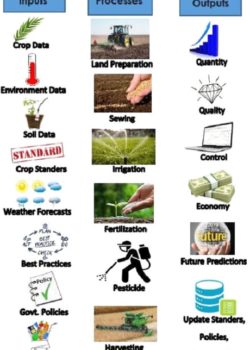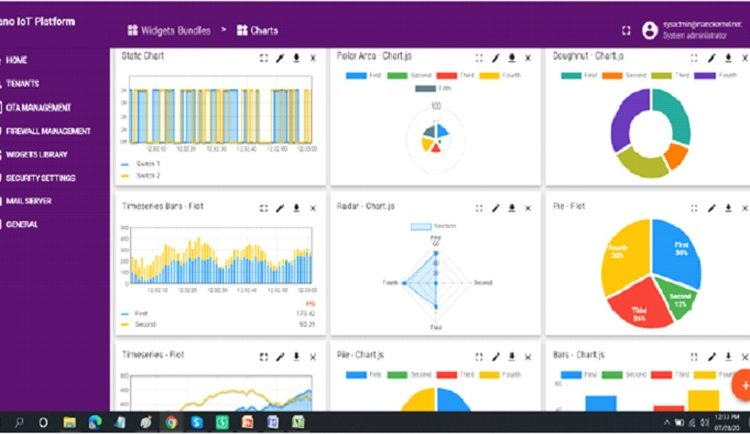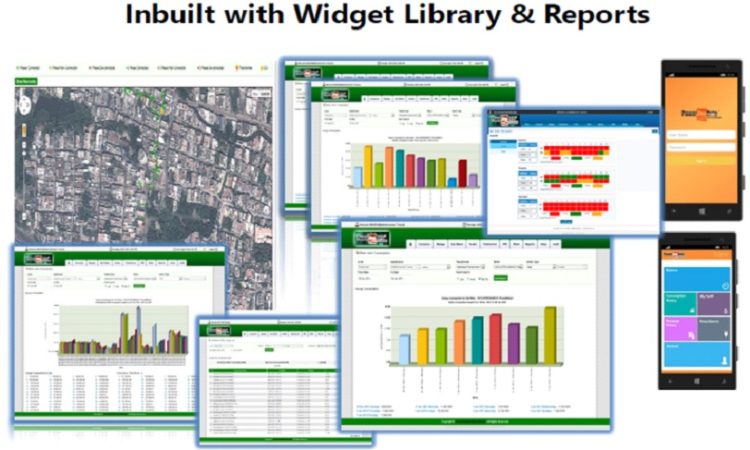AI and IoT Based
Smart Agriculture, Healthcare, Manufacturing
The rapid emergence of the Internet-of-Things (IoT) based technologies redesigned almost every industry including Smart Agriculture, Healthcare and Manufacturing. Such revolutionary changes creates new opportunities along with a range of challenges.
Namely, there are five ways IoT can improve the process:
⦁ Data collected by the applied sensors track the state of your business in general, as well as staff performance, equipment efficiency, etc.
⦁ The ability to foresee the output of production/result allows for better product distribution, control over internal processes and lower production risks.
⦁ Waste and error reduce due to better control.
⦁ Increased business efficiency through process automation.
⦁ Better control over the production/operation process and maintain higher output, quality and growth capacity through automation.
As a result, all these factors eventually lead to higher revenue and optimum operating condition.



Smart Agriculture Technology
Hierarchy of major applications, services and wireless sensors being used for smart agriculture applications.
General Hierarchy of Possible Applications, Services and Sensors for Smart Agriculture.
IOT offers solutions to the many traditional farming issues like drought response, yield optimization, land suitability, irrigation and pest control
Soil Sampling and Mapping
Sensing technologies help to optimize and adapt to changing environmental factors.
- Factors that are critical to analyze the soil nutrient levels include soil type, cropping history, fertilizer application, irrigation level, topography, etc.
- Soil mapping enables the sowing of different crop varieties in a specific field to better match soil properties like seed suitability, time to sow, and even the planting depth, as some are deep-rooted and others less.
- By utilizing a soil testing tool kit, any farmer, without having any lab experience, can analyze up to 100 samples per day (overall, more than 22,000 nutrient samples a year) without visiting any lab.
- In very rural area, remote sensing is being used to obtain frequent soil moisture data which helps to analyze the agriculture drought in far regions.
- Soil Moisture and Ocean Salinity (SMOS) satellites which provides global soil moisture maps every one to two days can be used to calculate the Soil Water Deficit Index (SWDI).
- By employing a moderate resolution imaging spectro radiometer sensor to map various soil functional properties, the land degradation risk can be effectively estimated and used to develop the prediction models.
- Sensors and vision-based technologies are helpful to decide the distance and depth for sowing the seed efficiently. Sensor and vision-based autonomous robot can be designed and developed for sowing seeds.

Irrigation
- Various controlled irrigation methods, like drip irrigation and sprinkler irrigation are being promoted to tackle the water wastage issues.
- Precise soil and air moisture control system using wireless sensors makes optimal use of water that leads to better crop health.
- Increase in crop efficiency with the use of IoT-based techniques such as crop water stress index (CWSI) irrigation management system.
- A wireless sensors-based monitoring system transmits measurements to a processing center for analysis by software applications.
Fertilizer
- A more precise estimate of the required dose of nutrients minimizes the negative effects on the environment.
- Specific soil nutrient level measurements based on various factors such as crop type, soil type, soil absorption capability, product yield, fertility type and utilization rate, weather condition, etc.
- Enabling technologies like Normalized Difference Vegetation Index (NDVI), GPS accuracy, geo mapping, Variable Rate Technology (VRT) and autonomous vehicles strongly contributes to smart fertilization.
Crop Diseases and Pest Management
- Real-time monitoring, modeling, disease forecasting are acquired throughout the crop area using field sensors, UAVs or remote sensing satellites.
- Remote sensing imagery covers large areas and leads to higher efficiency with lower cost.
- Field sensors are capable to collect data like environment sampling, plant health and pest situations throughout the crop cycle for study.
- IoT-based pest management system can automate traps, capture and count, and even characterize the insect types and uploads these data to the Cloud for detailed analysis.
Yield Monitoring, Forecasting & Harvesting
- Yield monitoring is the mechanism used to analyze crop yield, grain mass flow, moisture content, and harvested grain quantity.
- Crop forecasting is an art to predict the yield and production (tons/ha) before the harvest takes place. This forecasting helps the farmer for near-future planning and decision making.
- This monitoring covers various development stages and uses fruit conditions like its color, size, etc., for this purpose. Predicting the right harvesting time not only helps to maximize the crop quality and production but also provides an opportunity to adjust the management strategy.
- A yield monitor linked with the mobile app FarmRTX displays live harvest data and uploads it automatically to the manufacturer’s web-based platform.
- This app has the ability to generate high-quality yield maps and share these maps with an agronomist and the farmer also has the option to export to other farm management software to analyze them
Climate-smart Livestock Production
GRAZING MANAGEMENT
- Increase the efficiency of grazing management through rotational grazing to match the livestock’s needs with the availability of pasture resources.
- Rotational grazing allows for the maintenance of forages. This enhances the quality and digestibility of the forage, improves the productivity of the system and reduces methane emissions per unit of live weight gain.
- These measures can also enhance soil health and water retention which increases the resilience of the grazing system to climate variability.
PASTURE MANAGEMENT AND NUTRITION
- Pasture management measures involve the sowing of improved varieties of pasture, typically replacing native grasses with higher yielding and more digestible forages including perennial fodders, pastures and legumes.
- The intensification of pasture production though fertilization, cutting regimes and irrigation practices may also enhance productivity, soil organic carbon, pasture quality and animal performance (e.g., milk or meat yield).
Animal Breeding
- Crossbreeding programs can deliver simultaneous adaptation, food security and mitigation benefits.
- Crossbreeding strategies that make use of locally adapted breeds (that are not only tolerant to heat and poor nutrition but also to parasites and diseases) may become more common with climate change. Adaptation to climate change can also be fostered by switching livestock species.
Herd Management, Disease Control And Feeding Strategies
- In addition to enhanced animal health management to maintain and improve animal performance, the management of disease risks may also become increasingly important because there may be an increase in the emergence of gastro-intestinal parasites due to climate change.
- Breeding more disease resilient animals is one approach to addressing this issue.
Early Warning Systems And Insurance
- The use of weather information to assist rural communities in managing the risks associated with rainfall variability is a potentially effective preventative option for climate change adaptation.
- In situations where risks are unacceptably high for the private sector, public- private partnership approaches to index-based livestock insurance, in which the public sector underwrites a share of these risks, could play an important role.
Improved Waste Management
- Most methane emissions from manure derive from swine and beef cattle feedlots and dairy cattle, where production is carried out on a large scale and manure is stored under anaerobic conditions.
- The captured methane can be flared or used as a source of energy for electric generators, heating or lighting.
Improved Feed Conversion
- Improved feed conversion ratios have already greatly reduced the amount of feed required per unit of animal product.
- Feed efficiency can be increased by developing breeds that grow faster, gain weight more quickly or produce more milk. This can be done by improving herd health through better veterinary services, preventive health programs and improved water quality.
Improving Energy Use Efficiency
- Improving energy use efficiency, wherein the amount of energy used per unit of product, is an effective way to reduce production costs and lower emissions.
- Energy is used for milking process, cooling and storing milk, heating water, lighting and ventilation.
- Heat exchangers cooled by well water, variable-speed drives on the milk pump, refrigeration heat recovery units and scroll compressors are all energy conservation technologies that can reduce the energy consumed in the cooling system. These technologies can reduce greenhouse gas emissions, especially in countries where the energy sector is emission intensive.
Major Equipment and Technologies
- Usage of multifunctional imaginary devices equipped with remote sensing platforms such as satellites, agriculture airplanes, balloons and UAVs.
- Various types of sensors—those that are mostly deployed for specific purpose across various sites of our interest. The gathered data is identified with the precise location information by using GPS devices so that the site-specific treatment can be provided afterwards.
- Efforts are being focused to offer more sophisticated tools such as agricultural robots to perform a range of activities like planting, watering, weeding, picking, thinning, fertilizing, spraying, packing and transporting. This revolution is being driven not only due to the advancement of technology but also a result of factors like fear of losing the low-cost labor, most importantly need for better and cheaper food.
Wireless Sensors
Wireless sensors are being used as standalone wherever required, further integrated with almost every portion of advanced agricultural tools and heavy machinery depending on application requirements.
Acoustic Sensors
- It functions by measuring the change in the noise level as the tool interacts with other materials, e.g., soil particles.
- Acoustic sensors are commonly used for pest monitoring and detection and classifying the seed varieties according to their sound absorption spectra.
OPTICAL SENSORS - Measure soil organic substances, soil moisture and color, presence of minerals and their composition, clay content, etc.
- These sensors test the soils’ ability to reflect light based on different parts of the electromagnetic spectrum.
Ultrasonic Ranging Sensors
- Sensors of this category are commonly used in tank monitoring, spray distance measurement and monitoring crop canopy.
Optoelectronic Sensors
- Optoelectronic sensors can help to detect weeds, herbicides and other unwanted plants especially in wide-row crops.
- Capable of differentiating between vegetation and soil from their reflection spectra.
Airflow Sensors
- Measures soil air permeability and percentage of moisture and identifying soil structure to distinguish different types of soils.
- The desired output is the pressure required to push a predetermined amount of air into the ground at a prescribed depth including compaction, structure and moisture levels.
Electrochemical Sensors
- Analyze soil nutrient and pH levels.
Electromagnetic Sensors
- Measures residual nitrates and organic matter in the soil.
Mechanical Sensors
- Assess the soil mechanical resistance (compaction) to indicate the variable level of compaction.
Mass Flow Sensors
- It provides the yield information by measuring the amount of grain flow, e.g., when passing through the combine harvester.
Eddy Covariance-based Sensors
- Used for quantifying exchanges of carbon dioxide, water vapor, methane or other gases, and energy between the surface of the earth and the atmosphere.
Soft Water Level-based (swlb) Sensors
- SWLB sensors are being utilized in agriculture catchments to characterize hydrological behaviors such as water level and flow at adjustable time-step acquisitions.
Light Detection And Ranging (lidar)
- Land mapping and segmentation, determining soil type, farm 3D modelling, monitoring erosion and soil loss and yield forecasting.
- LiDAR is also commonly used to obtain dynamic measurement information regarding fruit-tree leaf area and when combined with GPS, it can produce 3D maps.
Telematics Sensors
- Used to collect data from remote locations (especially inaccessible points), operations of machines that report on how the components are working and record location and travel routes to avoid visiting the same patch.
- These services enable farm managers to record and store all information related to farm operations automatically, which maximizes the utilization of environmental benefits and minimizing threats like farm equipment theft.
Remote Sensing
These sensors also found significant use in agriculture applications including crop assessment, forecasting yield dates, yield modelling, identification of plants and pests, land cover and degradation.
Communication in Agriculture
Factors like cost, coverage, energy consumption and reliability are critical and must be considered before choosing the means of communication.
Low-energy networks can provide connectivity only on one site and mostly do not offer services in remote areas where data need to be transmitted to the farm management system.
Cellular Communication
- Cellular communication modes from 2G to 4G can be suitable, depending on the purpose and bandwidth requirement; however, its reliability / availability in rural areas is a major concern.
- Data transmission via satellite is another option, but its cost is high, making it unsuitable for small and medium sized farms. The choice of communication mode also depends on application requirements, such as some farms require sensors that can operate with low data rate but need to work for long periods hence demand long battery life.
- For such scenarios, a new range of Low Power Wide Area Network (LPWAN) is considered a better solution for cellular connectivity, not only in terms of long battery life but also a larger connectivity range with affordable rates (2 to 15 USD per year)
- Currently, crop and pasture management are two of the main applications where LPWAN networks are highly suitable and can be utilized in many other farming-related uses.
- Other communication network/application like Zigbee, Bluetooth, LORA and Sigfox are widely used.
Cloud Computing
- Real-time computation, data access, and storage to users without the worry of physical location and configuration of the system that delivers the services.
- Cloud computing offers an edge to farmers to use knowledge-based repositories that contain a treasure of information and experiences related to farming practices as well as on equipment options available in the market with the necessary details.
Transportation
It is a crucial matter to structure a plan to distribute food while maintaining its quality. Transporting existing available food products safely and efficiently to more people is the real subject of issue of this industry.
- Implementing an automatic method that uses wireless sensors to measure and record temperatures can substantially improve food safety.
- This method allows for a continuous data stream of temperatures 24 hours a day, 7 days a week. Temperatures can be recorded consistently and on time, leaving little room for interpretation.
- The recorded data can be stored on the Cloud and accessed via any type of internet-connected device.
- Notifications will be sent out in real-time if temperature strays outside preset limits, allowing for immediate action to remedy the situation.
- IoT offers predictive maintenance and indicates when the monitoring equipment nears its life span, enabling timely replacement before it fails and compromises on product quality.
- These IoT systems have potential to monitor and maintain quality at every stage of the supply chain, from production to consumption
Healthcare Technology
Pain Points For Retirement Homes:
Loneliness
- Needing someone to interact
- Need to be with people of same interests
Mood management
⦁ Gather data form devices/sensor/wearable gadgets
⦁ Slice and dice data to personalize the delivery of information
Daily Activities Management
- Booking of facilities, connect with others of the same interest etc
- Assist in scheduling or activities
- Voice activation or controlled motion activation services
- Automate daily routines
Living Condition
- Avoid sick building syndrome by using good architectural design
Solutions For Retirement Homes:
Creating a WOW factor in providing services
- Not creating new devices or sensors
- Using existing technology
Reinventing the delivery of services
- Using data collected from devices
- To personalize the data to cater for individual needs.
- Using of AI and IoT to enhance the living condition
- Creating an interactive AI
- Connecting the data to the relevant parties for action
- Creating personalized assistant and trainer hologram






















